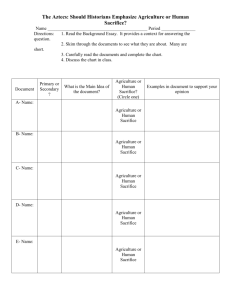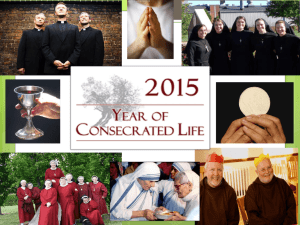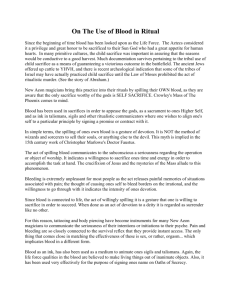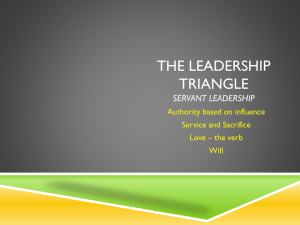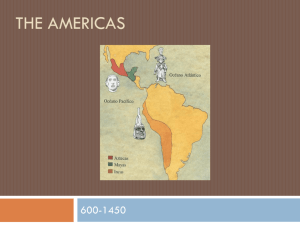Worth the Sacrifice A Per icianship from Monks
advertisement
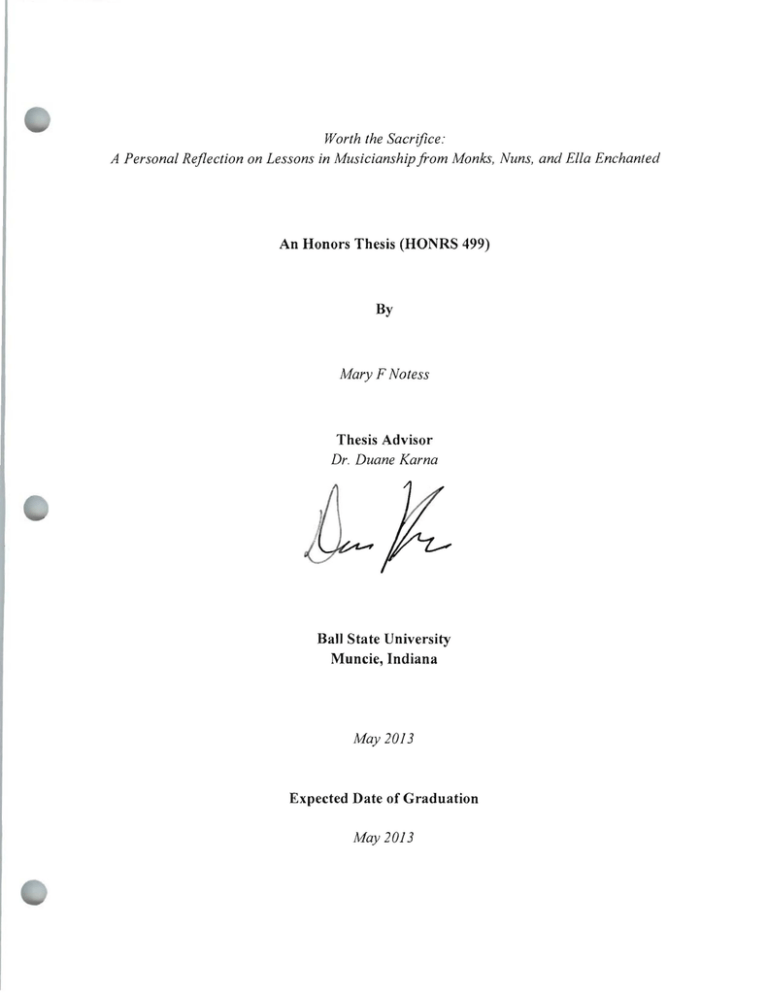
Worth the Sacrifice : A Personal Reflection on Lessons in Musicianship from Monks, Nuns, and Ella Enchanted An Honors Thesis (HONRS 499) By Mary F Notess Thesis Advisor Dr. Duane Karna Ball State University Muncie, Indiana May 2013 Expected Date of Graduation May 2013 Abstract The professional musician makes many sacrifices to perfect their art. Sometimes we can best understand the choices we make through fictional stories. Other times greater understanding can come from lifestyles that have similar structure or ideals. In looking briefly at the popular children's novel Ella Enchanted, I examine what makes the life of a musician worth the sacrifices. From there I look to the lives of consecrated religious lnen and \\Tomen for a more practical and concrete vision for musicianship. To provide a more specific iUustration~ my own experience and growth as a musician in college serve to illuminate the conclusions that I have drawn from integrating elements of monasticism into my music. Acknowledgements I would like to thank Dr. Duane Karna for his assistance and guidance on this thesis. He not only helped me to focus my writing and ideas, but also helped me to look more broadly at hovv to apply what I have learned. I would like to thank my private oboe instructors Dr. Aryn Day Sweeney, Professor Cox, and Mr. Clinch for helping to guide and direct me as my oboe playing has developed through college. Lastly, I would like to thank my family, professors, and friends who have let n1e share my discoveries and reflections with them. I aln so grateful for the encouragement to keep learning and the interest and enthusiasm with which they listened as I processed all these ideas. Worth the Sacrifice I In the well-known children ' s book Ella Enchanted, Ella is cursed by a spell that forces her to obey every direct order given her. Ultimately because of her love for the prince and her country, she has the strength and willpower to break the curse in a moment of crisis. In that moment, she realizes that every previous time that she had tried to break the spell the reason was not great enough. Whether it was when her stepsister stole a precious necklace, her stepmother forced her to work as a slave, or when she was trying to save a young dwarf from an ogre, none of these occasions were enough to break the spell. Only when her obedience had the full and imminent capacity to destroy both the man that she loved and her entire kingdom was it sufficient. She says, "In that moment I found a power beyond any I'd had before, a will and a determination I would never have needed if not for Lucinda, a fortitude I hadn't been able to find for a lesser cause. And I found my voice.'" In that moment, Ella rejects the marriage proposal of the prince, and thus breaks the spell. What she discovers at that point is that the prince and the kingdom are more important to her than anything she had ever desired or worked for in the past. Therefore she is willing to give up everything that she desires, to sacrifice her dreams, her plans, her very self in order to save them. As a little girl and as a teenager (and to be honest even now) there has always been something about this story that I love. It was not the ordinary reimagining of Cinderella. This version has stuck with me in a way that others have not. Beyond the appeal of adventure, there are two different aspects of this retelIing that particularly stand out as both elements that attracted me to the story and that still pertain to my life. The first of these is the struggle between freedom and obedience that Ella faces. Ella is deprived her free will, something that is so fundamentally human. At any point she can be forced into a good or bad decision. Part of what makes her so stubborn was the knowledge that she had to comply if she was given an order. She I Gail Carson Levine, Ella Enchanted (New York: HarperCollins, 1997),226. Worth the Sacrifice 2 has no freedom to choose to obey or not. Being naturally stubborn myself, that interrelationship between freedom and obedience continues to fascinate and challenge me. The other element of Ella Enchanted is that of selfless sacrifice for the good of the other. Throughout the book, much of Ella's focus is on herself and her own life. Granted, this is not always bad, and considering that she is the main character, that is not surprising. But especially when the curse and the effects of the curse are being discussed , Ella's thinking is focused on what she is forced into. At the climax of the book, when Ella breaks the curse, she forgets about herself. All she knows is she needs to break the curse for the sake of the prince and the kingdom. They are worth the sacrifice. Her struggle has always fascinated me. Especially in college I have spent a great deal of time trying to figure out what makes the sacrifices I am making worth it. As a music major spending hours in the practice room or making oboe reeds, I have plenty of time to think. To really improve at oboe has involved relinquishing some of my freedom in order to develop dedication and discipline. That also meant making a lot of sacrifices, and I wanted to know what made the music worth the hours spent and the opportunities lost. Ella Enchanted in a way gives that answer. We sacrifice our freedoms; we surrender our own plans and desires out of love for others. As much as I love this book and the message it sends, it is a children's book in a make­ believe land full of fantastical creatures, fairy godmothers, and magic spells that, despite its powerful message, offers very little practicality to my life as a musician. And while I do love metaphors and try to draw lessons even from the struggles of my favorite storybook characters, I also need practicality and concrete application. The question then is how to make that leap that connects inspiration and idealism with applicability and concrete change. So what does make the sacrifices required of a musician worth it? Essentially, what is sufficient justification for the Worth the Sacrifice 3 decisions that I was making? Initially, I chose music because I liked it, I was good at it, and I had nothing else that I was really drawn to at the time. By the end of my freshman year I had begun to realize the inherent selfishness of my decisions. Moreover, I was finding that I lacked sufficient motivation to develop disciplined and consistent practice habits. It was over the course of my sophomore year that things began to change. As I started taking music history and learning more about the role of the sacred in the development of modern music, I also started learning about the consecrated religious life (essentially the lives of monks and nuns), a topic that still inspires and fascinates me. Remarkably, as I learned more about monasticism I found numerous connections between the life of the monastic and the life of a musician. Once I began to more deeply study the consecrated life, I started incorporating elements of the monastic into my practice, performance, and daily life - both consciously and unconsciously. Gradually through the process of learning musicianship from monasticism (and even at times monasticism from musicianship) answers to those questions that had pestered me since freshman year started to become clear. And the answers to those questions were manifest in practical and applicable ways. Strange as it may sound, consecrated religious life gave the tangible vision and structure to my musicianship that the fantastical world of Ella Enchanted could not provide. Due to the diversity of lifestyles referred to as monastic or consecrated religious today, these need to be defined for this context. Because it has been the most directly applicable to my musicianship, I shall focus on the coenobitic (communal) consecrated religious life within the Roman Catholic tradition. The religious life has existed from the first centuries of the Christian Church. In the exhortation Vita Consecrata, Pope John Paul II sums up the essence of the consecrated life: "By the profession of the evangelical counsels the characteristic features of Worth the Sacrifice 4 Jesus - the chaste, poor and obedient one - are made constantly "visible" in the midst ofthe world and the eyes of the faithful are directed towards the mystery of the Kingdom of God already at work in history, even as it awaits its full realization in heaven.,,2 These counsels are taken as publically professed vows of poverty, chastity, and obedience, and it is held that through these the religious is wholly dedicated to love and serve God above all else. 3 Through these vows they are "intimately consecrated to divine service" and seek to grow in love and serve both the 4 Church and the world through prayer and service. The coenobitic religious life is lived in community, organized under the direction of a rule of life and an abbot or abbess, establishing a way oflife that is supported and enhanced by centuries of theological exegesis and religious communities. Before the connection to musicianship can be illuminated, some key elements of the religious life ought to be further clarified and explained. The vow of poverty is twofold, encompassing both factual or material poverty and spiritual poverty. These two aspects are incredibly interdependent. This voluntary poverty is emphatically not an embracing of destitution or squalor. 5 Rather, it is based in the understanding that we enter the world with nothing and will leave the world with nothing. All of creation is to direct our minds and hearts to the truth. Therefore in order to love God and neighbor above all, we are to be content with having only what we need and not seek after superfluities. Furthermore, in the face of another's poverty it our personal responsibility to help - not only from our overabundance, but even from our own need. 6 This call is directed to all Christians. However, it must be understood that the things in this world are not considered inherently bad or John Paul II, Vita Consecrata. 25 Mar. 1996, Papal Archive, The Holy See <http://www.vatican.va/> . Section I. Paul VI, Dogmatic Constitution on the Church ~ Lumen Gentium. 21 Nov.1964, Papal Archive, The Holy See <http://www.vatican.va/> . Section 44. 4 Paul VI, Lumen. Section 44-46. 5 Thomas Dubay, Happy are You Poor (San Francisco: Ignatius, 2003), 11. 6 Dubay, Happy, 12. 2 J Worth the Sacrifice 5 evil. A religious from the Marianite order, Fr. Thomas Dubay states "Because it is a negation in itself, poverty is not sought for its own sake but for what it makes possible and much easier to attain: a radical readiness, a sensitivity to what Jesus is about, a sharing with the needy, an apostolic credibility, a pilgrim witness in a world of dwindling resources.,,7 For the consecrated religious, this vow is lived more radically. Religious manifest this in a renunciation of any personal ownership of material goods . The little they do have belongs to the community. This utter reliance on God's providence is based in the trust and faith that God will provide whatever we need or lack and if He does not, it was never truly necessary. The human is both body and spirit, and for every corporal reality there is often also a spiritual reality. 8 While material poverty is the physical manifestation of poverty, if it is not matched by poverty in spirit, the renunciation of possessions by the religious is in vain. Spiritual poverty is grounded in humility - the recognition that by ourselves we are not sufficient, that we need others, and that we need God .9 It is supplemented by the recognition that we cannot control the world around us. Humility is one of the virtues in which the religious seeks to grow in order to more fully give of themselves. This humility is not a self-degradation or assumption that we are less than someone or something else, for then Christ (who as God is above all else) could not be humble. Rather, it is an action, a choice, and a placing of ourselves in a lesser state. This example is modeled by God, who in humility became man to redeem mankind. He took on the lesser state, the lower position, and so in imitation of Christ, Christians Dubay, Happy, 14 . 8 Catholic Church, Catechism ofthe Catholic Church (New York: Image Doubleday, 1997), section 302. 9 Raniero Cantalamessa, Sober Intoxication ofthe Spirit trans. Marsha Daigle-Williamson, (Cincinnati : Servant Books, 2005), 33. 7 Worth the Sacrifice 6 are to do the same. 10 This interrelationship between poverty and humility has taught me some unexpected and powerful lessons in musicianship. While our motivations are rarely single-minded or simple, it is generally understood that one does not become a classically trained musician for the money. Many will go into music simply because they love it or because it is their way to express emotion and experience (though of course this list is far from exhaustive). Though I did not necessarily think much about my motivations going into my major, this played a role in my decision. At its heart, my motivation was my desire to play and perform good music because I liked the experience of it. But I got caught up in the struggle of becoming a musician. I was constantly frustrated with my poor playing, I got incredibly nervous in even small performances, and the contents of my reed case became a thermometer for my moods. I saw only the impossibility of the notes on the page or the frustrations of cracks in an expensive new instrument. I was choked and exhausted, so I practiced only half-heartedly. There is a freedom that comes with letting go of over-possessiveness - either of material things or image and ideas. This directly affected my performances, private lessons, and reed­ making. As I began thinking about the fact that things will not last forever, I realized that I tried to control everything - my technique, my intonation, my tone, my reeds, my phrasing, and even other performers I played with. Needless to say, that did not work. My need to be in control came not from a desire for power, but a compulsion to succeed. The micromanaging thus stemmed from the belief that I would thrive only if I worked hard enough and fulfilled all the requirements. For me it took two different realizations to begin to grasp my own insufficiency and the necessity of detachment. First, I watched others get constantly frustrated with their instruments 10 Cantalamessa, Sober, 23-24. Worth the Sacrifice 7 not working or their perfonnances being less than perfect. They were constantly unsatisfied and unhappy. I realized that I did not want to be stuck in that cycle. Second, during my sophomore year, my new oboe cracked repeatedly and I developed some health issues that interfered with oboe. It made me realize that ultimately, I am not and cannot be in control. Moreover, I am not defined by the oboe, my ability (or inability) to play, or even the quality of my perfonnance. The world does not revolve around my oboe life. It is far bigger than that. The fact that I have the opportunity to be a musician here and now is such a gift. My performances end with the last piece, my reeds last a week or two, my oboe itself will probably crack again, and I may not always be able to play. But that cannot eradicate the lessons I have learned from being a musician or the ways in which I have grown as a person. It merely shows that I must be more than what I have or what I do. At any given time, the most I can do is do my best. Recognizing that helps me learn to trust that the rest will indeed be provided and shows me just how truly I am insufficient by myself. It is a very humbling realization. One of the other vows taken by consecrated religious is the vow of obedience. This is very counter-cultural today, and seems to directly contrast the story of Ella Enchanted discussed earlier. Yet the two are actually very different. Ella's curse was indeed a curse because she was denied the freedom to choose obedience. She was deprived free will. On the other hand, the vow of obedience is chosen freely . This is done in imi tation of Christ, who carne to do only the will of God and became obedient unto death. I I The religious seek to unite themselves wholly to the will of God by offering their willfulness as a sacrifice. They submit themselves to the authority of the Church, their Rule of life, and their superiors, in whom they see the living presence of Christ. 12 This vow certainly does not equate a rejection of original thought, opinions, or feelings. Rather it II 12 John 4:34, Phi12:8 Paul VI, Decree on the Adaptation and Renewal ofReligiolls Life - Perfectae Caritatis, 28 Oct. 1965, Papal Archive, The Holy See, <http ://www .vatican .va>. section 14. Worth the Sacrifice 8 is taken in order to imitate the example of Christ, grow in humility, and to be more fully free to serve and love . Many will endeavor to also submit themselves in obedience to their neighbor when at all possible, so long as what they are being asked is good and does not contradict their Rule of life. In this way they grow more fully in humility and love. A beautiful example of the vow of obedience lived out can be seen in St. Jeanne Jugan, foundress of the order the Little Sisters of the Poor. In 1839 at age 47, Jearme J ugan took an old homeless woman into her home and gave the woman her bed. From this act of charity was born the order of the Little Sisters, who care for the elderly poor. For four years she led the sisters, until in 1843 she was removed from her position by a well-intentioned but ambitious priest. She quietly obeyed, continuing to serve and not protesting when news was spread that another had founded the order. But in 1852 even as the order flourished and grew, she was quietly removed from all her duties and sent to live among the novices. Again, she did not protest or assert her role or authority as foundress. Instead, she lived her vows quietly among the novices for her remaining 27 years of life. In the end, though she died in obscurity, she was well loved by the young sisters. She had spent all those years training and guiding young sisters to humbly serve the poor, grow in holiness, and remain faithful to God and their vows. 13 She was able to shape the order for years to come through her humble obedience. Tied very closely to the vow of obedience is the rule of the order. The rule dictates the structure and spirituality of the community, providing a balance of prayer and work for the day as well as establishing governance and clarifications for the specific community. Each has a daily honorarium, or schedule, that guides their daily activities. Their work and other activities are spaced throughout the day, marked by periods of community prayer, usually six different times . Ideally, by its structure an order will resemble a building for which Christ is the 13 Paul Mjlcent. Jeanne Jugan : Humble S o As to Love More, trans. Alan Neame (London : Darton, 2000). Worth the Sacrifice 9 foundation on which the house was built, the Church and its teachings are the major support beams, and the rule is the frame and interior skeleton of the building. For each house, the beams are placed in different arrangements, creating a home suitable to the inhabitants. In a likewise manner rules differ from one order to the next, but are all built using the same materials, on the same foundation. Just as the walls provide a structure that protects and enhances the life of the family within, the rule is not meant to constrict or stifle, but rather to liberate the community to more fully live lives of prayer and service. Learning to embrace that structure of obedience and discipline as a musician has been both incredibly challenging and deeply rewarding. Excellence necessitates dedication. In music, that dedication is manifest most obviously in a consistent and disciplined practice schedule. As I began college, there was absolutely no regularity to my practicing. I was an expert at making excuses for myself and postponing my more intense practice and reed-making sessions until right before my lessons. Without a structure or any discipline, I kept spinning my wheels and repeating the same mistakes, sitting comfortably in musical mediocrity instead of improving. Over the course of the first two years of college, the number of conunitments that I made gradually accumulated . Eventually I learned that I had to say no to good things fairly consistently in order to say yes to the things I had already agreed to do, with one of the greatest commitments I had already made being as a music student. While I had no "rule" to follow, in a way every musician creates one of their own. Scales and intonation work had to become a consistent part of my practice sessions, "I had to practice and work on reeds incrementally each day. The grunt work takes up a lot of time and is limiting, but when spaced throughout the day and broken up by the other work and my other activities it became manageable. Any consecrated religious would affirm that if they postpone all of their Worth the Sacrifice 10 prayers to the end ofthe day it becomes overwhelming. Not only does it become overwhelming, but it reduces their openness to growth. That is exactly what I was doing my first two years of college. It is through the daily practice of growing in virtue, consistently returning to prayer, and practicing little acts of self-denial that a religious is more fully able to fulfill their vocation. And it is through daily practice that a musician is more fully able10 fulfill theirs. Carmelite nun St. Therese of Lisieux did not think herself capable of great sacrifices or acts of heroic love, but she sought the opportunity to do little things for others out oflove and quietly accepted slights and annoyances as a chance to unite herself to Christ. Through this she built habits of virtue and love so strong that she was able to reach many through her prayers and example of patience as she suffered from tuberculosis. Her life would have been forgotten inside the monastery, except that under obedience to her superior she wrote a simple and unassuming biography of her life. Despite the fact that she never left the convent from her entrance at only fifteen until her death at twenty four, because of her fidelity to loving through the little things she was named a Doctor of the Church 14 and still continues to reach many today. J 5 To the artist, structure is not a foreign concept. This is something many of my professors have conveyed. Dr. Keith Kothman advised me this year to compose a small amount every day to build a habit of composing and to hone and refine skills. Dr. Scott Routenberg told us of skilled jazz musicians who would practice scales for hours on end each day. Each of these methods is intensely structured and rather stringent and pedantic. But they produce some of the best and most creative composers and improvisers precisely because they have a strong foundation upon which to create their works of art. Dr. Keith Sweger provided the lesson that all music cannot be played totally free and with great rubato. To the listener that just sounds messy. 14 This is a title given to holy men and women who have by their learning and writing have contributed a substantial renewed and deeper understanding of some aspect of theology. There are only 34 . 15Joseph Yann, ed., Lives ofthe Saints (New York: Crawley, 1954),451-457. Worth the Sacrifice 11 Rather, music ought to be performed with great rhythmic, technical, and tonal precision (requiring much practice with scales and a metronome). This provides a structure and foundation for the listener. From there, some rubato can be used and vibrato can be added, each providing color and expression by enhancing the musical line through contrasting. Just as a house without walls cannot stand, neither can music convey its message without rhythm or a basic structure. It can be a challenge to find the appropriate balance between a legalistic approach to technical mastery of my instrument or music and conveying expression and musicality. Personally I overcorrect, as I will play with poor rhythm and overly nuanced phrasing on one day and then strict rhythm and no expression or direction the next. This is where the expertise of others is very helpful. Just as a religious is guided personally by a spiritual director and generally by their superiors, my private teachers, ensemble coaches, and directors help identify problems and guide me towards finding that balance. Writers of some of the great spiritual classics offer three different pieces of advice that, though directed to guide growth in holiness and the practice of virtue, also help center and direct my practice sessions. The first piece of advice is addressed to consecrated religious and clergy who have become tepid in living out their vocation and faith stating, "Without care and diligence you will never acquire virtue. [... J It is greater work to resist vices and passions than to sweat in physical toil. He who does not overcome small faults, shall fall little by little into greater ones. ,,16 This helps to remind me that excellence in music requires a great attention to detail, constant work and growth, and great honesty with myself about how I actually play. This can be a challenge to maintain. Fr. Thomas Dubay affinns this, stating that "the eroding process begins with petty comer cutting and small infractions and UlUloticed infidelities.,,17 The, second piece of advice 16 Thomas A Kempis, The Imitation a/Christ, ed. William A. Carroll (New York: Catholic Book, 1947),82. 17 Dubay, Happy, 139. Worth the Sacrifice 12 comes from Lawrence Scupoli' s book The Spiritual Combat, wherein he states that, "You must know your dominant passion which must be singled out as your greatest enemy, the first to be attacked.,,18 This is fantastic advice because often the largest issue with my playing causes many of the peripheral ones. A perfect example of this comes from a lesson I had on an etude. I had no grasp of the phrasing or melodic line in the piece and I had no clue what the music was trying to portray. By fixing that issue, my struggles with rhythm, dynamics, tempo, and vibrato in that etude all began to resolve of their own accord. Finding a balance between the attention to detail and the larger problems in my playing has to shape my practicing. The third piece of advice that I have to keep in mind allows me to focus on the first two without becoming discouraged. From the Cannelite order, Brother Lawrence writes of how disheartened he got with his apparent lack of progress and growth, but then realized that he "was trying to show, at the beginning of my walk, the same maturity it had taken other Christians years to achieve.,,19 Improvement takes time, but when I spend days and months working on one piece or skill it is easy to get frustrated and not notice any changes. This has been so helpful to keep in mind as I practice because it not only helps me stay motivated, but it reminds me that I will never achieve the level of proficiency of a professional unless I work diligently on a daily basis. Maintaining the discipline and regular practice schedule that is required for musical excellence can be challenging, especially when friends and family make plans that are far more appealing. Often the well-intentioned practicing succumbs to the tyranny of the present - the pleasure of the moment is far more attractive than sacrificing for the sake of the future. For me, this was the seed of mediocrity in my musicianship, because music was not the one thing I loved 18 19 Lawrence Scupoli, The Spiritual Combat, trans. William Lester and Robert Moran (New York: Paulist, 1978),49. Brother Lawrence, The Practice ofthe Presence ofGod (New Kensington : Whitaker, 1982),36. Worth the Sacrifice 13 or desired most. Though not devoid of pleasure, more often it was an avenue for more intensified growth and learning. This made the diligence in practicing seem both difficult and constricting for me. Ultimately this demonstrates the need for community. In one of his meditations, poet John Donne states that, "No man is an island, entire of itself; every man is a piece of the continent, a part of the main.,,2o In the earlier discussion of humility, the recognition of our own insufficiency was established. Action is necessitated by this realization and is actualized in community. One of the challenges of our increasingly interconnected culture today is that it is easier than ever to self-select our experiences. I can choose what news I read, what subjects I study, what people and movements I follow, easily blocking out or ignoring the rest. I can block people I disagree with out of my life and surround myself with only ideas that I accept or are comfortable. It is far easier to walk away from organizations and even relationships that are falling apart than to try to fix them. Yet if I do that, I simply carry the experience of brokenness and the emotional wounds it has caused into my other relationships. This is where learning about and experiencing the community aspect of religious life has transformed my own musicianship and daily choices. St. Benedict considered the coenobitic (communal) lifestyle to be superior to other fOTITIS of religious life. This is because the monks were not subject to their own whims or as easily able to deceive themselves because they were held accountable by the community and the abbot. 21 Furthermore, the challenge of maintaining and nourishing relationships within the community helps the members of the community to grow in character, virtue, and holiness. The centrality of community has been emphasized in 2°John Donne, Meditation XVII, Accessed 2 May 2013 < http ://www .online-literature.comJdonne/409/> . 2lBenedict ofNursia, The Rule a/St. Benedict, trans. Francis Aidan Gasquet (New York: Cooper, 1966),7-8. Worth the Sacrifice 14 Christianity since its earliest days and is counted as one of the four pillars for the Christian life laid out in the Acts of the Apostles. 22 The Rule of St. Basil addresses the necessity of living among those pursuing the same goal of holiness and intimacy with God and warns of the dangers of pursuing this alone. He enumerates how the community helps to strengthen those who are struggling and by personal example provides positive pressure to grow. It also helps prevent the religious from becoming selfish and self-centered, providing daily opportunities to test and strengthen their ability to love at all times.23 St. Augustine also lays out a vision for community life emphasizing "oneness of mind and heart," and calling for a unity in the pursuit of holiness that levels all preexisting class · · . 24 dIstlnctlOns. I had the opportunity to experience firsthand the power and challenge of living in community last summer, when I was able to live and work with the Little Sisters of the Poor. Each sister there felt called to the order, which has over 5000 sisters serving in 31 different countries worldwide. Under their vow of obedience these sisters can be placed at any of the homes and moved as needed. This means that they do not choose the sisters with whom they live and serve, offering a stark contrast to the aforementioned self-selecting group which we can so easily create for ourselves. However, many of the sisters would affinn that living in community is one of the hardest and best aspects of religious life. One sister encouraged me to learn to recognize how we affect others and to resolve conflict quickly, to forgive, and above all to love in spite of all faults. While we may not always get along, those who frustrate and annoy us the most are usually the ones who can help us grow the most, even though we may not enjoy it. 22 23 24 Acts 2:42 Daniel Marcel La Corte and Douglas J. McMillan, compo Regular Life: Monastic Canonical and Mendicant Rules. 2 nd edition (Kalamazoo: Medieval Institute, 2004), 38-9. La Corte and McMillan, Regular, 55-6. Worth the Sacrifice 15 In many ways, the workplace resembles the religious community, in particular within the life of an ensemble musician. We do not select the musicians we perform with, nor do we necessarily like the ones with whom we have to work. Regardless, for the sake of the music we submit ourselves to the authority and guidance of conductors and section principals. In an ensemble where the musicians do not respect or respond to the conductor, the group struggles. Likewise, when all of the members of the group participate for different reasons and with varying levels of commitment, the ensemble also struggles. Furthermore, if players are unwilling to accept and embrace criticism or to charitably assist and correct other performers, the ensemble can get stuck in mediocrity. The religious community thrives in which all are directed towards the one goal of drawing close to God and each accepts their Rule as the common method for exercising their specific apostolate (for example teaching or caring for those terminally ill with cancer). Witnessing how this unites different consecrated religious showed me both how ensembles could function, and how they often did not function. This is the attitude with which I try to approach my ensemble playing now. I cannot force the group to be united in their common motivation and goal, but I have the capability to change mine. The greatest witness I can give is by personal example. There are little changes I can make that have transformed my interactions with other musicians. Refusing to complain about directors or listen to complaints about them can be difficult, but it makes me much more open to the guidance of the director and happier to play in rehearsals. Seeking the opinion and guidance of other performers in regards to my own playing is humbling, but it both improves my performance and communication with other members of the ensemble. Most profound though is the way in which my relationships with the other musicians have changed. The strongest friendships I have with other members of the music department are those I originally found most Worth the Sacrifice 16 frustrating and annoying. Through honesty, openness, and a lot of humility in seeking forgiveness, these relationships were transfonned, which helped in tum to transfonn my ensemble playing (an unexpected, yet welcome result). The understanding of community in the lives of consecrated religious is deeply tied to the broader Christian understanding of the Mystical Body of Christ. The basis for this comes from scripture. "For as in one body we have many parts and all the parts do not have the same function, so we, though many, are one body in Christ and individually parts of one another.,,25 Later it is stated, "There may be no division in the body. [... J If one part suffers, all the parts suffer with it; if one part is honored, all the parts share its joy.,,26 Christ is the head and the body is made up of the members of the Church, united by the Holy Spirit and sustained by grace. There are two implications of this understanding that most directly apply. First, each member of the body has a role that they are uniquely created to fill. They have the free will to refuse or accept that role. A thumb works best and most fully while working with the fingers and hand. It can do little good attached to the knee. However, the Body of Christ is not all thumbs. If it were, little would be accomplished (another reason to avoid a self-selecting a community that only thinks like me). Religious communities are founded to fill specific roles, and through their way of life seek to fulfill that and aid others to do the same?7 The second implication is that everything we do, for good or for ill, affects the rest of the community. As the rest of the body is affected when an ankle is broken or the immune system over-reacts, so too do our actions affect the rest of the community.28 If something is wrong with our bodies we work incredibly hard to Rom. 12:4-5, NAB 1 Cor. 12:25-26, NAB 27 Theresita Polzin, The Mystical Body o/Christ in Lesson Form (Collegeville Liturgical, 1961),5 . 28 Polzin, Mystical, 17. 25 26 Worth the Sacrifice 17 fix the problem. We can do the same on a larger and broader scale. For a religious community, this is a guiding principle for many of their decisions. This concept has great implications and applicability for musicians. If in an ensemble all try to playas a soloist, without listening to the other players, the cohesion in the music is lost. A simple illustration for the second point can be made using intonation. If everyone in an ensemble is playing the correct notes with the correct intonation, but one person is playing the wrong note or with terrible intonation, the error is usually obvious to the listener. Naturally when the soloist is playing poorly it is far more obvious than when the last chair violinist is playing poorly. Nevertheless, both detract from the musicality being conveyed. If! am the one causing the problem, I would like to be challenged, assisted, and encouraged to amend my playing. This seems self-explanatory, but we are often stopped by a variety of inhibitions, the fear of offending not least among them. Part of the beauty of studying and experiencing the religious life has been discovering that the more I learn, the more depth and beauty I find. Their life is lived in total commitment to God by radically following the example of Christ. In its essence, the consecrated life is very simple. But that simplicity contains profound layers and a deep and strong foundation that has held over the centuries. Furthermore, their life is not obsolete in society today and I continue to discover connections to my own life. Time and time again I would realize that the things I was struggling with in general would come up in my private lessons because I was wrestling with the same issue in my oboe playing (for example consistency or attention to detail). Gradually I began to understand that playing oboe was not so much a way for me to reach others, but a way for me to grow and learn. My practice and reed-making sessions are not only where I tackle problems in my oboe playing and hone my skills, but they are also a place where I confront who I am and Worth the Sacrifice 18 what I have to offer to the world. I very firmly believe that one cannot seriously spend hours alone in a practice room with their instrument without confronting who they are as a person. With their hours in silence and prayer, neither can a religious. Ultimately, consecrated religious must seek to live a balanced life. While their whole life is motivated by the choice to seek and love God above all, they must balance prayer and work, community and solitude, action and contemplation, and structure and freedom. There is a natural tension between the extremes, but that is part of the challenge and beauty of their life. Love is a choice, and out of a deep love for God, vowed religious choose freely to remain poor, chaste, and obedient. In so doing they gain Christ and the kingdom of Heaven. Oddly enough, though it outwardly appeared different, that is what Ella chose. She freely chose slavery to her stepmother over the riches of the palace, she rejected the prince's marriage proposal, and she chose the obedience of a slave instead of the authority of a queen. In doing so, she broke the curse and gained the hand of the prince and the rule of the kingdom. Naturally not every life looks exactly like these, but what is clear is that the two are based in freely chosen and selfless sacrifice. Thus I return to my initial question: what makes the sacrifices required of a professional musician worth it? I think the answer lies in the freedoms that those sacrifices enable: the freedom to love and the freedom to make a difference in the lives of others through music. For me, I find that the greatest fruits of my practice sessions come in the ways in which I change and grow and the conversations that stem from my work. Performance is not really an avenue through which I consistently am able to make a difference - which is fine because neither is it really satisfying to me. This gives me a beautiful insight into the role music will likely play in my future. For me to spend all my time perfecting my oboe playing would be selfish because it eliminates the opportunity to share the fruits of my labors. However, to completely cut music out Worth the Sacrifice 19 of my life would likewise be foolish and selfish because it truly is a way in which I process the world. It allows me to learn and grow, so that I may then better go out and serve those around me. So I must now find a new balance in my playing, one that grants me the freedom to love and serve most fully in whatever role I may be asked to fill. If continuing to practice and play daily even without pursuing a career in music grants me that freedom, then that is a sacrifice worth making. Worth the Sacrifice 20 Works Cited Benedict ofNursia. The Rule ofSt. Benedict. Translated by Francis Aidan Gasquet. New York: Cooper Square, 1966. Brother Lawrence. The Practice ofthe Presence ofGod. New Kensington: Whitaker, 1982. Cantalamessa, Raniero. Sober Intoxication ofthe Spirit. Translated by Marsha DaigleWilliamson. Cincinnati: Servant Books, 2005. Catholic Church. Catechism ofthe Catholic Church. New York: Image Doubleday, 1997. Donne, John. Meditation XVII. Accessed 2 May 2013 < http://www.online­ literature.com/donne/409/>. Dubay, Thomas. Happy Are You Poor. San Francisco: Ignatius, 2003. John Paul II. Vita Consecrata. 25 Mar. 1996. Papal Archive. The Holy See. <http://www.vatican.va/holy_father/john ~aul_iilapost_ exhortations/documents/hfjp­ ii- exh- 25031996- vita-consecrata- en.html>. Kempis, Thomas A. The Imitation ofChrist. Edited by William A. Carroll. New York: Catholic Book, 1947. La Corte, Daniel Marcel and Douglas J. McMillan, compo Regular Life: Monastic Canonical and Mendicant Rules. 2 nd edition. Kalamazoo: Medieval Institute, 2004. Levine, Gail Carson. Ella Enchanted. New York: HarperCollins, 1997. Milcent, Paul. Jeanne Jugan: Humble So As to Love More. Traslated by Alan Neame. London : Darton, 2000. Paul VI. Decree on the Adaptation and Renewal ofReligious Life - Perfectae Caritatis. 28 Oct. 1965. Papal Archive. The Holy See < http://www.vatican.va/archivelhist_councils/ ii_ vatican_councilldocuments/vat-ii_decree_19651 028~erfectae-caritatis_en.html>. Worth the Sacrifice 21 Paul VI. Dogmatic Constitution on the Church - Lumen Gentium. 21 Nov.1964. Papal Archive. The Holy See <http://www.vatican.va/archive/hist_councils/ii_vatican_council! documents/vat-ii_const_19641121_lumen-gentium_en.html>. Polzin, Theresita. The Mystical Body ofChrist in Lesson Form. Collegeville: Liturgical, 1961. Scupoli, Lawrence. The Spiritual Combat. Translated by William Lester and Robert Moran. New York: Paulist, 1978. Vann, Joseph, ed. Lives ofthe Saints. New York: Crawley, 1954.
